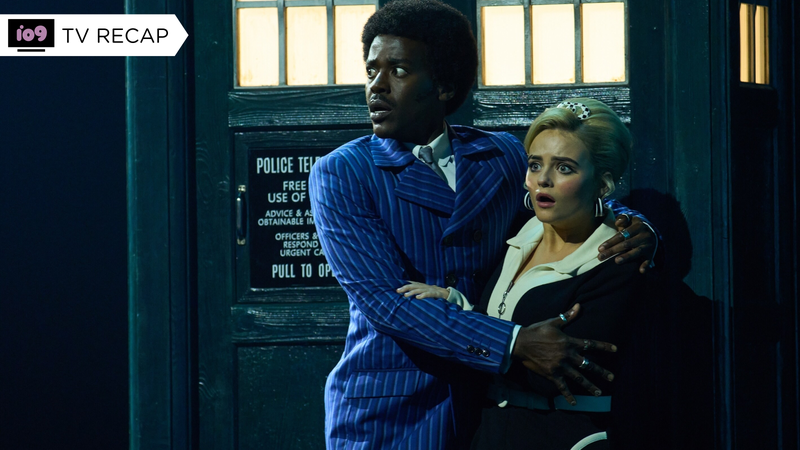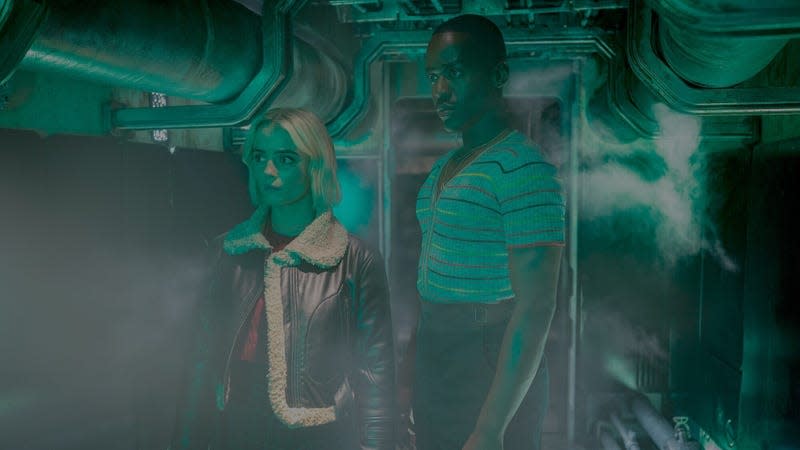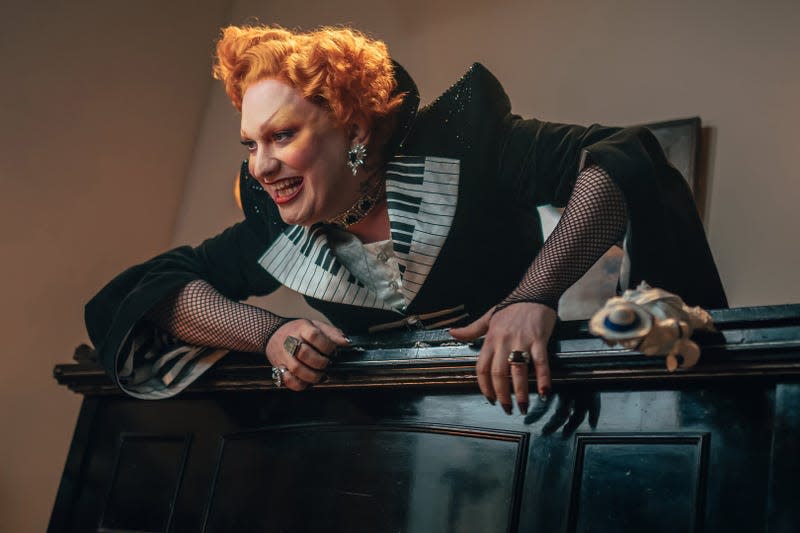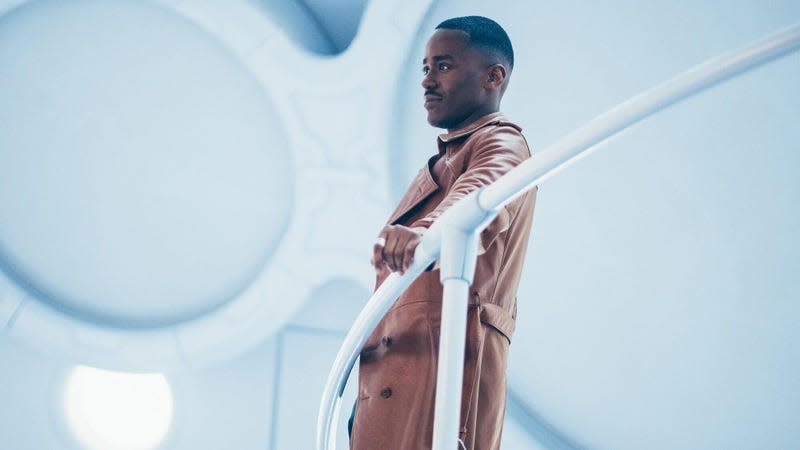Doctor Who Returns to Remind Us We're All Stories, in the End

- Oops!Something went wrong.Please try again later.
- Oops!Something went wrong.Please try again later.
Doctor Who is one of the most malleable shows on Earth. Its heroes change every few years, its titular one literally transforms into someone new. Every week a different time, a different space, a different tone—and a new chance to deliver a story that’s also wildly malleable in quality. Doctor Who is about storymaking, but rarely is that part of the text in the way the show’s new era is laying down some intriguing hints as to how it might be now.

“Space Babies” and “The Devil’s Chord,” the two episodes that launched Ncuti Gatwa and Millie Gibson’s debut season as Doctor Who’s newest stars, are a peculiar pair to launch on—especially with a bigger platform and push the show has had in years, with its new major home on Disney+ around the world. Much of what could be said about them, we’ve already said in our spoiler-free review—they’re fun, light, splashy in their use of Doctor Who’s rejuvenating budget, and anchored in a trifecta of excellent performances: in Gatwa and Gibson across both, joined by Jinkx Monsoon as the marvelous Maestro in “Chord” to give this new era its first breakout villain (one thankfully banished, rather than destroyed, so a return visit could be in the cards, although death has rarely stopped anyone in Doctor Who before, anyway).

They’re also kind of not great episodes, either. They’re not the show’s worst by any means. They’re good in that they’re fast and fun, but not great in that they really can’t offer enough to stick in your mind the second you stop watching. Both “Babies” and “Chord” suffer from a breakneck pacing that takes breeziness a bit too far, never really sitting in one place for long enough to give one of the 15 different ideas they want to play with time to breathe for more than a few moments. While as a duology they fit that Doctor Who one-two punch of quickly showcasing the series’ premise—one trip forward in time, one trip back—they’re also very similar episodes in that they lean heavily on one end of the series’ tonal balance, a little more silly than serious, and often to the point of an unhelpful indulgence. Is it nice that Doctor Who now has money to spend ending an episode on an entirely irrelevant, extended song-and-dance number, its heroes joined by a legion of snazzily dressed back-up dancers? Yes. Would it have been better for the episode to feel like it actually had an ending, instead of being abruptly cut off by said song-and-dance sequence after 45 minutes of near-breathless running around? Also yes!
That doesn’t mean that neither episode has something to say though. “The Devil’s Chord” is the meatier of the two in this regard—“Space Babies” is seemingly more interested in treating like saying the word “babies,” then clarifying “space babies,” is worthy of an entire narrative premise. But both episodes are, in their best moments, connected by one idea that is seemingly laying the groundwork for this new era of the show: an awareness that we’re all living one big story, full of tropes and ideas we know and can manipulate. On a broad level, this is entirely what “Space Babies” is about. The Doctor and Ruby discover that the futuristic orbital baby farm they’ve landed on is being menaced by a creature so fearsome it even scares a Time Lord that has seen everything. They then realize the entire scenario is based on a malfunctioning computer system realizing its young wards’ need for storytelling as a fundamental building block of their existence and creating a typical fairy tale for them to live out, a literal monster—this is Doctor Who at its silliest, so the monster is made out of literal baby snot as a collected waste byproduct—to be fought by a hero to save the day.

But “The Devil’s Chord” takes this awareness of storytelling and runs with it in darker, weirder, and more compelling ways. There’s Maestro themselves—a being from outside our known constraints of time and space who feasts on the very nature of sound itself, from the whispers of the universe to the potentiality of a song or set of notes. The setting itself—1963 at what would become the famous Abbey Road studios—having its creative lifeblood sucked out of it to such a manner that humanity “turns sour,” as the Doctor puts it to Ruby at one point, is all about reminding us how storytelling enriches us and allows to connect with and understand one another on a higher plane. But most interestingly of all is how “Chord” frequently plays with the rules of storytelling, within and without the text.
Multiple times throughout the episode characters make it aware to us as an audience that they understand they are not just participating in the narrative, but they are participating in an episode of television that we are watching. After murdering their first victim, Maestro sits at a piano and plays the opening bassline to Doctor Who’s title theme, screeching us into the opening sequence. Later on, captions for a sequence where Maestro plays a similar set of notes more aggressively at the Doctor and Ruby labels them specifically as Who’s prior metanarrative riff on its own iconic bassline: the “drums” that plagued John Simm’s incarnation of the Master at the behest of the Time Lords themselves. At the climax of the episode, the Doctor makes a knowing gag that he thought the episode’s soundtrack was non-diegetic—that it did not exist in the story itself—until he realizes that Maestro is literally playing with the notes of it to ensnare Ruby in a trap. Speaking of, even Ruby herself is a key part of this metatextual idea—breaking Maestro’s control over her in the climax as a narrative deus ex machina, because the sound of her debut story (or specifically, the “Carol of the Bells,” which played in the flashbacks to Ruby being left at the church on Ruby Road by her mysterious birth mother) is hidden deep inside her, with a power that scares even this primordial entity of sound itself.

These are all moments in stories that never quite manage to slow down enough to actually spend all that much time unpacking them. But they’re an interesting expansion of whatever this new “pantheon”—established by the Toymaker in Who’s 60th anniversary specials—has at play in being creatures from beyond whatever became of the universe after the lackluster events of Jodie Whittaker’s swan song season and “The Flux.” There’s enough of them that, even as slight as they are, they still cut through the sound and relentless fury of this premiere to let us know that maybe, at some point, this season of Doctor Who will have something with a bit more meat on the bone to chew at.
Maybe that’s all Doctor Who’s return needed to give us: a bit of glitz, a bit of glam, two new protagonists who are brimming with energy and potential, and a little sideways glance as to what it might be cooking with next, a power that goes beyond villainous threat and into the metanarrative of why we make stories at all. That would be a compelling question to raise for an era of the show that is, as new as it wants to be on the surface, driven by the return of old creative forces. As always with Doctor Who, time will tell if it’s all leading to some place worth it.
New Doctor Who episodes premiere Fridays at 7 p.m. ET on Disney+, and will broadcast through the BBC iPlayer at the same time in the UK, at 12 a.m. local time on Saturdays before broadcasting on BBC One later that day.
Want more io9 news? Check out when to expect the latest Marvel, Star Wars, and Star Trek releases, what’s next for the DC Universe on film and TV, and everything you need to know about the future of Doctor Who.

